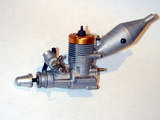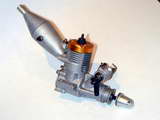| Name | Taipan 2.5 R/C | Designer | Gordon Burford |
| Bore | 15mm | Stroke | 14mm |
| Type | Schneurle ported glowplug | Capacity | 2,474cc (0.151 cuin) |
| Production run | Moderate | Country of Origin | Australia |
| Photo by | Ron C (engine from VRS collection) | Year of manufacture | 1973-76 |
Background
Many owners argue that this Taipan represents the pinnacle of Gordon Burford's long career as an engine designer. While aimed directly at the high performance market, the engine was still modestly priced, leading to Model Airplane News Free Flight columnist, Dave Linstrum, dubbing it "[the] Poor man's Rossi?" [1]. The first version of the engine (pictured above) was introduced at the end of 1973, although pre-production versions had appeared at the 1972 Australian Nationals Quarter Midget Pylon racing event, recording the five fastest times of the meet [2]. Fitted with a conventional venturi and spraybar in place of the Taipan R/C throttle, the sturdy engine also gained popularity in FAI F1C free flight events as well as control line racing and combat.
Technical Description
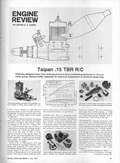 This Taipan is a twin ball-race, Schneurle ported, glowplug ignition, high performance engine. It was available with and without the compensating-type R/C throttle. Peter Chinn's review of the '75 model (more on the two variants later) reported a peak power reading of 0.52BHP at about 22,000 RPM on 25% nitro fuel with the muffler removed. This placed the engine right "up there", performance-wise, being slightly better than the best Schneurle .15 tested by Chinn up to that time.
This Taipan is a twin ball-race, Schneurle ported, glowplug ignition, high performance engine. It was available with and without the compensating-type R/C throttle. Peter Chinn's review of the '75 model (more on the two variants later) reported a peak power reading of 0.52BHP at about 22,000 RPM on 25% nitro fuel with the muffler removed. This placed the engine right "up there", performance-wise, being slightly better than the best Schneurle .15 tested by Chinn up to that time.
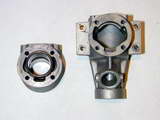 The engine uses a diecast crankcase with a separate cylinder jacket casting that surrounds the Schneurle ported liner. As can be seen in this photo, this arrangement simplifies the formation of the complex, angled transfer and boost ports. These ports, together with the large rear-facing exhaust port remove a large amount of metal from the liner, so the close fitting sleeve helps prevent distorting at the operating temperature. Also visible, although perhaps not obvious, is the offset of the venturi inlet to the right of center-line (viewed from the rear). This has the effect of providing a tangential flow of the inlet charge, in the direction of rotation.
The engine uses a diecast crankcase with a separate cylinder jacket casting that surrounds the Schneurle ported liner. As can be seen in this photo, this arrangement simplifies the formation of the complex, angled transfer and boost ports. These ports, together with the large rear-facing exhaust port remove a large amount of metal from the liner, so the close fitting sleeve helps prevent distorting at the operating temperature. Also visible, although perhaps not obvious, is the offset of the venturi inlet to the right of center-line (viewed from the rear). This has the effect of providing a tangential flow of the inlet charge, in the direction of rotation.
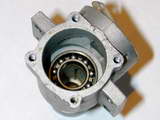 The crankcase carries two ball races. The rear has a 10mm ID with nine balls; the seven ball front bearing has a 7mm inside diameter. The central portion of the shaft runs unbushed in the crankcase. Visible at the top of this photo is a channel that transfers lubrication from the inlet to the front bearing. Both ball-races are of the unsealed type.
The crankcase carries two ball races. The rear has a 10mm ID with nine balls; the seven ball front bearing has a 7mm inside diameter. The central portion of the shaft runs unbushed in the crankcase. Visible at the top of this photo is a channel that transfers lubrication from the inlet to the front bearing. Both ball-races are of the unsealed type.
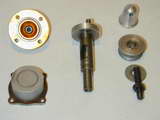 The design underwent some small but significant changes with the 1975 model year. The earlier engines featured a die cast backplate; later ones introduced a light weight, injection moulded replacement. The other change was to the crankshaft counterbalance. The first version seen here features a pressed-in crankpin with counter-balances cut peripherally into the thick crankweb, over which is pressed an aluminium ring—clearly visible in the photo. This feature, popular on other high-performance engines, maximises primary compression by presenting a "full volume" crankweb, even though it has been counter-balanced. The '75 model reverted to conventional crescent cut-outs, favouring better balance over pumping action.
The design underwent some small but significant changes with the 1975 model year. The earlier engines featured a die cast backplate; later ones introduced a light weight, injection moulded replacement. The other change was to the crankshaft counterbalance. The first version seen here features a pressed-in crankpin with counter-balances cut peripherally into the thick crankweb, over which is pressed an aluminium ring—clearly visible in the photo. This feature, popular on other high-performance engines, maximises primary compression by presenting a "full volume" crankweb, even though it has been counter-balanced. The '75 model reverted to conventional crescent cut-outs, favouring better balance over pumping action.
The crankshaft also features a generous oil channel at the front end and what had become standard on Taipans: a threaded stud insert for the prop nut. I've never understood why this great crash-damage minimizing feature has not become the norm, rather than the exception. The prop driver is fitted to the 7mm section of the shaft with a split aluminium cone. Note that the 3/16" stud has both a conventional prop nut and a threaded spinner nut, recessed for the hex nut. This arrangement provides a degree of redundancy in prevention of shaft runs.
The anodized aluminium head has a narrow squish-band, with a trumpet shaped combustion chamber, sealing to the cylinder liner with a copper gasket. The head, liner, and sleeve assembly is retained by four, long, 2.5M.6 Posidrive screws (I'll have a little rant about this type of screw head later).
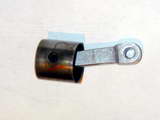 The cast iron piston is flat-topped. Not obvious is the work that has gone into lightening it by removing material above the wrist pin boss as well as below. The floating wrist pin is retained by tiny wire circlips and is lightened by a blind drilled hole. This had me mystified, and Peter Burford must have had a grin on his face when he pointed out to me that a open hole would connect the Schneurle boot port to the atmosphere as the piston descended, before transfer started. I quietly muttered "doh!" and crawled back in my box. The rod is machined from aluminium and highly polished. A single oil hole is drilled just off the vertical axis in the big end. The early rods were unbushed. The '75 series engines carried bronze bushes at both ends.
The cast iron piston is flat-topped. Not obvious is the work that has gone into lightening it by removing material above the wrist pin boss as well as below. The floating wrist pin is retained by tiny wire circlips and is lightened by a blind drilled hole. This had me mystified, and Peter Burford must have had a grin on his face when he pointed out to me that a open hole would connect the Schneurle boot port to the atmosphere as the piston descended, before transfer started. I quietly muttered "doh!" and crawled back in my box. The rod is machined from aluminium and highly polished. A single oil hole is drilled just off the vertical axis in the big end. The early rods were unbushed. The '75 series engines carried bronze bushes at both ends.
 One of the most distinctive features of the engine is the angled expansion chamber muffler, vaguely suggesting a tuned pipe—which it is most assuredly not. The muffler is drilled for an optional muffler pressure tap, but that is not the thing on the top; that is a priming jet. Careful examination of the full-size photo here will disclose the cross-drilled priming hole, conveniently arranged at the middle of the exhaust, and the fact that the outer side of the fitting is contoured for quick application and removal of a priming tube. The pressure nipple on the other hand carries a conventional retention bayonet ridge. It can be fitted to either side of the muffler body, or closed off altogether. The muffler body is another Taipan die casting, fitted with a turned cone at the rear. Engines were supplied with two screw-in orifices, cross drilled for tightening with a light tommy-bar. The second one seen here is the low-noise insert.
One of the most distinctive features of the engine is the angled expansion chamber muffler, vaguely suggesting a tuned pipe—which it is most assuredly not. The muffler is drilled for an optional muffler pressure tap, but that is not the thing on the top; that is a priming jet. Careful examination of the full-size photo here will disclose the cross-drilled priming hole, conveniently arranged at the middle of the exhaust, and the fact that the outer side of the fitting is contoured for quick application and removal of a priming tube. The pressure nipple on the other hand carries a conventional retention bayonet ridge. It can be fitted to either side of the muffler body, or closed off altogether. The muffler body is another Taipan die casting, fitted with a turned cone at the rear. Engines were supplied with two screw-in orifices, cross drilled for tightening with a light tommy-bar. The second one seen here is the low-noise insert.
 For those who prefer to run crankcase pressure, the top left-hand backplate retention screw hole has been drilled through into the crankcase with an appropriatly tiny drill (all others are "blind"). This enables the screw to be replaced with a pressure nipple as seen here, or closed off. Notice that the screws carry an embossed 'X' at 45° to the slots. This identifies them as Posi-drive screws and guarantees that any attempt to apply a Phillips or ISO cross-point 'driver will just result in mutilated screws. If you have one of these engines, do yourself and the world a favour: go out and buy a #2 POSI screwdriver before being tempted to attack the screws!
For those who prefer to run crankcase pressure, the top left-hand backplate retention screw hole has been drilled through into the crankcase with an appropriatly tiny drill (all others are "blind"). This enables the screw to be replaced with a pressure nipple as seen here, or closed off. Notice that the screws carry an embossed 'X' at 45° to the slots. This identifies them as Posi-drive screws and guarantees that any attempt to apply a Phillips or ISO cross-point 'driver will just result in mutilated screws. If you have one of these engines, do yourself and the world a favour: go out and buy a #2 POSI screwdriver before being tempted to attack the screws!
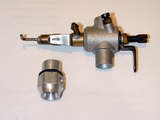 The Taipan-designed and made R/C throttle is of the compensating type, fitted with a steel barrel in a die cast aluminium body. The barrel carries a separate idle-adjusting needle. The bore is 6mm. The bore of the fixed venturi is 6.85mm, but remember it will be obscured with a 4mm diameter spray-bar. Strangely, the throttle protrusion diameter is 9.5mm, while that of the venturi is 9.85mm, the latter being a good fit in the crankcase, while the throttle is distinctly wobbly. Both are retained by two opposing Allen-key grub screws in the offset case inlet.
The Taipan-designed and made R/C throttle is of the compensating type, fitted with a steel barrel in a die cast aluminium body. The barrel carries a separate idle-adjusting needle. The bore is 6mm. The bore of the fixed venturi is 6.85mm, but remember it will be obscured with a 4mm diameter spray-bar. Strangely, the throttle protrusion diameter is 9.5mm, while that of the venturi is 9.85mm, the latter being a good fit in the crankcase, while the throttle is distinctly wobbly. Both are retained by two opposing Allen-key grub screws in the offset case inlet.
Conclusions:
 The MAN review [2] notes that this Taipan was available in the USA through Polk's Hobbies. The engine reviewed here comes from the collection of Van Richards-Smith. Noted Australian free-flight flier, John Lewis, reports that he has had crankpins loosen and damage the backplate on two engines. Peter Burford cannot recall any pressed-in Taipan crank pin ever comming loose, so maybe John was just not holding his mouth right. The crank of Van's engine is a very light fit in the ball-races (not a bad thing) and the backplate shows some sign of metal to metal contact at some time in the past, possibly starter motor induced as there is adequate if small clearance when the shaft is fully forward.
The MAN review [2] notes that this Taipan was available in the USA through Polk's Hobbies. The engine reviewed here comes from the collection of Van Richards-Smith. Noted Australian free-flight flier, John Lewis, reports that he has had crankpins loosen and damage the backplate on two engines. Peter Burford cannot recall any pressed-in Taipan crank pin ever comming loose, so maybe John was just not holding his mouth right. The crank of Van's engine is a very light fit in the ball-races (not a bad thing) and the backplate shows some sign of metal to metal contact at some time in the past, possibly starter motor induced as there is adequate if small clearance when the shaft is fully forward.
The "Goldhead" Taipan 2.5 BB marks a distict change from the Taipans of old. As well as being a noted contest performer for the time, it looks good—both in a model and on the shelf.
References:
| [1] | Linstrum, D: VTO: Free Flight Affairs Model Airplane News, Air Age Inc., Volume 91, Number 5, November 1975, p19. |
| [2] | Chinn, PGF: Engine Review: Taipan .15 TBR R/C, Model Airplane News, Air Age Inc., Volume 91, Number 1, July 1975, p47. |
![]()
